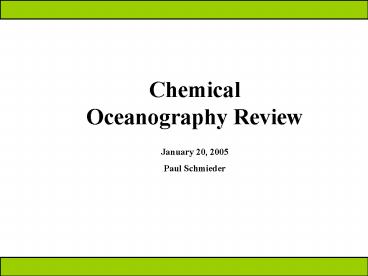Chemical Oceanography Review - PowerPoint PPT Presentation
1 / 34
Title:
Chemical Oceanography Review
Description:
Physical and Chemical Properties of Water. Major Constituents. Residence Times ... Biologically Important Chemical Species -Carbon, Phosphorus, Nitrogen, ... – PowerPoint PPT presentation
Number of Views:92
Avg rating:3.0/5.0
Title: Chemical Oceanography Review
1
Chemical Oceanography Review January 20,
2005 Paul Schmieder
2
Outline
Physical and Chemical Properties of Water Major
Constituents Residence Times Salinity and
Chlorinity Biologically Important Chemical
Species -Carbon, Phosphorus, Nitrogen, Silicon,
Oxygen Tracers -Phosphate Star, CFCs,
Tritium/He, etc.
3
Physical and Chemical Properties of Water
Physical and Chemical Properties of Water
High Boiling point, melting point, heat of
evaporation, surface tension, viscosity,
dielectric constant Density maximum at 4C
4
Properties of Water
5
Properties of Water
Hydrogen Bonding! 2 10 of the O-H bond
strength
6
Major Constituents in Seawater
These are conservative species. Species
concentrations are relatively homogeneous
everywhere.
7
Major Constituents in Seawater Residence Time
Residence Time Time required for the input of a
substance into a well mixed system to replace the
amount present.
? amount present / Input Rate
- Example Residence time of ocean water with
respect to river input - Ocean Volume / River Input
- 1.37 x 1018 m3 / 3.7 x 1013 m3/yr
- 37,000 years
Mixing times for the oceans is 500 1000 years.
Cl- has a residence time of 200 million
years..I.e. it is well mixed!
8
Salinity
Ideally, salinity is defined as the total amount
of dissolved salts in a given amount of water.
(units g/kg) Inaccuracy due to the method of
measurement 2 Methods of salinity
measurement 1. UNESCO (1962) salinity 1.80655
Clorinity per mil Chlorinity titrate
seawater with AgNO3. Apply the atomic weight of
Cl- to determine chlorinity. 2. Another
measurement is based on conductivity which has
no units.
9
Average surface salinity
10
Atlantic Ocean Salinity
11
(No Transcript)
12
Biologically Important Chemical Species
Carbon Carbon Pumps Phosphorus PO43- Nitrogen
NO3-, NO2-, NH4 Silicon H4SiO4 Oxygen
13
Carbon Pump
Processes that transfer carbon from the surface
ocean to the deep sea. It also extracts CO2 from
the atmosphere thus lowering pCO2 Composed of
three pumps Solubility pump results from the
increased solubility of a gas in colder
water. Soft tissue pump Bio Pump CaCO3 pump
production of CaCO3 at surface with
remineralization and deposition at depth CCD
(Carbonate Compensation Depth)
14
Carbon Pump
15
Carbon Pump
Global mean profiles of the three main carbon
pumps.
16
Phosphorus
- Considered a macro nutrient
- W.R.T river input, has a residence time of
70,000 yrs - Distribution is not uniform due to rapid
biological uptake and regeneration at depth
17
Phosphorus
18
P-O relationship
Note both Stochiometric and Geographic
Relationships!!
19
Atlantic and Pacific P Sections
Millero
Max P in N Pacific. P decreases in
Southward- Flowing water due to mixing
20
Surface distribution of P
Reflects balance between supply by upwelling and
biological utilization
21
Nitrogen
To a first approximation the distribution of N in
the ocean looks like P, with NO3 15
PO4. But, N is more complicated than P because
N exists in many oxidation states, and many
natural processes convert N between different
oxidation states. Nitrate (NO3-), Nitrite
(NO2-), Ammonia NH3/NH4 Urea (NH2-CO-NH2),
DON Nitrate (NO3) is thermodynamically stable in
presence of oxygen. Fixed N includes all
oxidation states except N2, because N2 fixation
is the first step to putting N in another
oxidation state. Nitrate Phosphate
relationship breaks down in low DO conditions and
denitrification occurs.
22
Nitrogen
23
Silicon
Forms Si(OH)4 equivalent to H4SiO4 Residence
time with respect to river input is 20,000
years Again, distribution is not uniform due to
rapid biological uptake. Used by organisms to
build shells diatoms, radiolarians, siliceous
sponges
24
Silicon
25
(No Transcript)
26
Silicon
Si increases with increasing age of water mass
27
N P scale linearly. Si is regenerated deeper
than N P. Opal Dissolution .vs.Organic
respiration
28
Identify Water Masses (1,2,3,4)
29
Conservative water mass tracers derived from
knowledge of Preformed nutrients
Broecker initially defined NO and PO, now
prefers Phosphate-star PO4. PO4
PO4meas O2/175 1.95 µmol/kg PO4 is
conservative (unchanged except by mixing with
water masses having a different value of PO4) so
long as ratio of O2 consumed to PO4 regenerated
is 1751 (moles/moles). 1.95 is a constant for
convenience.
30
PO4 provides an estimate of fraction NADW vs.
fraction AABW in any deep mixture of water masses
31
Based on PO4 deep waters in Pacific Indian
Oceans contain approx. equal fractions of NADW
and AABW
NADW (1.95 - PO4)/(1.95-0.73)100
32
Tracers and how they can be used
CFCs, 3H/3He, 14C Can be used to determine
source regions and relative amounts of water mass
mixing. What is needed 1. Known atmospheric
input function 2. Known sources and
sinks Examples Determine the amount of NADW
formation. Determine the age of DWBC and the
amount of mixing with outside waters
33
Tracers and how they can be used
34
References
Pilson, Michael E. Q. An Introduction to the
Chemistry of the Sea. Prentice Hall
(1998) Millero, Frank J. Chemical Oceanography.
Second Edition. CRC Press (2002)































